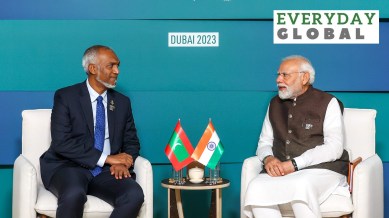What was the hydrographic survey agreement, and why is the Muizzu government against India’s presence? We explain.
What was the hydrographic survey pact?
Hydrographic surveys are carried out by ships, which use methods such as sonar to understand the various features of a water body. According to the US National Oceanic and Atmospheric Administration (NOAA), these surveys help “map out water depth, the shape of the seafloor and coastline, the location of possible obstructions, and physical features of water bodies”, to ensure the efficiency and safety of maritime transportation.
Prime Minister Modi travelled to the Maldives for a State Visit in June 2019, the first overseas visit of his second term. Various MoUs were signed during the visit, including one for Cooperation in the Field of Hydrography between the Indian Navy and the Maldives National Defence Force (MNDF).
What was planned as part of this pact?
The first meeting of the Joint Commission on Hydrography was held in the Maldives in September 2019. So far, three joint hydrographic surveys have been undertaken – in 2021, 2022, and 2023. The Indian Naval Ship (INS) Darshak carried out the first Joint Hydrographic survey in February and March of 2021.
According to a document from the High Commission of India in Male, the second Joint Hydrographic survey was carried out by the INS Sutlej from April 18 to May 24, 2022. “During the period, the ship surveyed Northern Maldives and the Male area including Thilafushi, Hulhumale and Male port on the request of the Government of Maldives,” it says.
Story continues below this ad
An area of 944 square km was effectively surveyed – some of these areas had been last surveyed as far ago as in 1853. Multi-beam echo sounders were used. The surveys were done to generate updated Navigational Charts/ Electronic Navigational Charts of the areas, which would help sectors such as Tourism, Fisheries, Agriculture, etc.
The ship was to also carry out tidal observations to enable accurate tidal predictions.
“The survey is in line with India’s policy of supporting the Maldives to set up Hydrographic facilities within the MNDF. In addition to the hydrographic equipment presented to the MNDF in March 2021, more equipment was gifted to MNDF by the Chief of Naval Staff in April 2022 for the Maldives Hydrographic office,” the document says.
Training was also imparted to MNDF personnel on the use of survey equipment. India said it would train more MNDF personnel at its Hydrographic Institute in Goa.
Story continues below this ad
The third survey was conducted between January and February 2023, by INS Investigator. It identified 52 new shoals, which are emerging ridge-like natural structures in the sea, within the Ihavandhippolhu atoll. Further training was imparted and relevant equipment was given to the MNDF.
Does India have such water survey pacts with other countries as well?
Yes. In 2021, India’s oldest Hydrographic Survey ship, INS Sandhayak, was decommissioned. In its 40 years of service, it undertook more than 200 major hydrographic surveys along the Western and Eastern coasts of the Indian peninsula, and the Andaman Sea, as well as surveys in neighbouring countries including Sri Lanka, Myanmar, and Bangladesh.
The government has previously cited a UN study that says approximately 50 per cent of coastal states have no hydrographic capability and another 25 per cent have only limited capabilities. Only the remaining 25 per cent, including India, have adequate hydrographic capabilities.
“There is, therefore, immense scope for international co-operation in hydrography, particularly so, in Asia and Africa, where 36% and 64% of the waters respectively, are yet to be surveyed systematically,” the National Hydrographic Office’s website says. It says Indian survey ships have assisted Kenya, Mauritius, Mozambique, Maldives, Oman, Seychelles, Sri Lanka and Tanzania in the past.
So why does Maldives want to end the pact?
Story continues below this ad
It has to do with the change of regime in the country following the elections in October this year. President Solih of the Maldivian Democratic Party (MDP), who was in power from 2018 to 2023, was seen as being more favourable to India, but his successor Mohamed Muizzu of the Progressive Party of Maldives (PPM) is being seen as more pro-China.
While the Maldives has traditionally been a part of India’s sphere of influence, in recent decades China has sought to project its power aggressively in the Indian Ocean, including through massive investments in infrastructure projects under President Xi Jinping’s Belt and Road Initiative (BRI).
In 2020, an ‘India Out’ campaign began in Maldives, alleging that New Delhi had sent a large military contingent to the Maldives – a claim that the Solih government repeatedly denied. During the election campaign, Muizzu said agreements with foreign countries must be terminated unless their presence was beneficial to the Maldives. This was seen as a reference to India – the Indian military is known to operate two helicopters and assist in search and rescue operations for people stranded or facing calamities at sea.
The Indian Express reported this week that Mohamed Firuzul Abdul Khaleel, Undersecretary for Public Policy at the Maldives President’s Office, had told a press conference that India had been informed that the Maldives does not wish to proceed with the agreement.
Story continues below this ad
Maldivian news outlet The Sun quoted Firuzul as saying the administration believes it is “best for national security to improve the Maldivian military’s capacity to conduct such surveys, and protect such sensitive information”.
